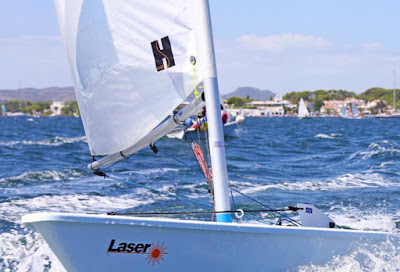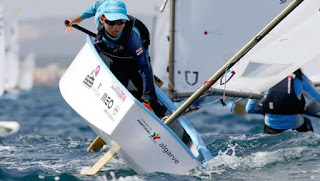It’s High Time to Slash the Price of the Class Laser Sails
 The are lots of changes upcoming with the Laser. It will change name shortly. There are likely legal changes that will be made to the international and national class associations, which will not be allowed to use the Laser name any longer.
The are lots of changes upcoming with the Laser. It will change name shortly. There are likely legal changes that will be made to the international and national class associations, which will not be allowed to use the Laser name any longer.And there will be new builders as, following the recent decertification of LaserPerfomance, the world supply of hulls is now in the hands of only two relatively small builders in Australia and Japan. And there are completely new rigs that the officials of the international class are looking at introducing.
On top of that, the Olympic future of the Laser will be decided later this year, possibly in May, by World Sailing.
There are lots of changes indeed in the making!
But what about the sails?
The recent introduction by LaserPerformance of « Club Edition » non-class Lasers has sent a bit of a global shock wave in the Laser world. Indeed, exactly the same boat, less the hull plaque and the sail button, are now available for a substantially discounted price, amounting to a 22.5 % discount over the regular price.
The availability of non-class sails has however been a reality for a much longer time. It's not a hidden feature. Many suppliers of class legal equipment also retail non-class sails.
And the discounts are way more substantial, while the sails are essentially the same, or very very close to being the same.
And let’s not forget. All Laser sails, class legal or not, typically don’t last long. All the top sailors compete with a new sail at any important event. A top sailor can easily use 10 sails per year, which amounts, with the current pricing, to about the same value of a complete brand new boat!
Even for medium level competitive sailors, in particular youth sailors, who use say 2 new sails per year, the budget allocated for sails can be as high as that for the full boat. Indeed, the boat will keep a residual value over the years, while used sails have essentially zero value.
For example, if your boat loses say US$2,000 value in 2 years, you may have spent about US$2,000 in sails during the same period. For the top sailors, the spending on new legal sails may be more like US$10,000 during such period.
Yes, the price of the sails matters a lot for the sailors' budgets, and for the accessibility of sailing, particularly in lower income countries, for less affluent families and for youth sailors.
Let’s have a look at the pricing of class v. non-class sails.
CLASS SAILS
Laser Sail - Standard Mark II (Hyde) - battens sold separately - US$650.00
Laser Sail Standard Mark 2 (North) - battens sold separately - US$604.35
Laser Sail - Radial (Hyde) - battens sold separately - US$650.00
Laser Sail Radial (North) - battens sold separately - US$604.35
Laser Sail - 4.7 (Hyde) - battens sold separately - US$574.00
Laser Sail 4.7 (North)- battens sold separately - US$573.75
Source: https://westcoastsailing.net/parts/laser/sails?sort=featured&page=2
NON-CLASS SAILS
a) Rooster Sailing
Laser Standard Practice Sail - Rooster Sailing - includes battens - US$225
Laser 4.7 Practice Sail - Rooster Sailing - includes battens - US$215
Laser Radial Practice Sail - includes battens - Rooster Sailing - US$247.00
Source: https://westcoastsailing.net/laser-radial-practice-sail/
b) Optipart
Laser Standard Practice Sail - Optipart - includes battens - US$490.95
Laser 4.7 Practice Sail - Optipart - includes battens - US$373.10
Laser Radial Practice Sail - Optipart - includes battens - $309.35
Source: http://www.apsltd.com/one-design-sailboat-parts/laser-sailboat-parts/laser-sails-battens-sail-bags.html?p=2
c) Neil Pryde
Radial Practice Racing Sail - Neil Pryde - includes battens - US$170
Source: https://neilprydesails.com/
d) iSails
Laser Standard Practice Sail - iSails - includes US taxes, excludes battens - US$149
Laser Radial Practice Sail - iSails - includes US taxes, excludes battens - US$139
Laser 4.7 Practice Sail - iSails - includes US taxes, excludes battens - US$129
Source: https://isails.com/
e) LaserPerformance
MK II Laser Training Sail. LaserPerformance. battens sold separately - US$470.00
Laser Radial Training Sail. LaserPerformance. battens sold separately - US$470.00
Laser 4.7 Training Sail. LaserPerformance. battens sold separately - US$450.00
Source: https://www.laserperformance.us/parts/sails/laser-sail?lang=en_US
f) Intensity Sails
Practice Sail for Laser Mk2 Radial Cut Full Rig - battens sold separately. Intensity Sails - US$159.99
Practice Sail for Laser Radial - Intensity Sails. battens sold separately - US$119.99
Practice Sail for Laser 4.7 - Intensity Sails. battens sold separately - US$99.99
Source: http://www.intensitysails.com
There are other suppliers of non-class sails. But this gives already a pretty good idea of the situation.
What is clear is that, over the years, several companies have found it interesting to supply non-class sails. And they all do so at a much lower price than the class sails.
As mentioned earlier, the sails are essentially the same or very close to being the same. For example, Intensity Sails notes on its website:
« Made of a firmer Dacron than the Class approved sail for better wear. Cut to class dimensions using same panel sizes. The sail has the same feel as the approved sail. »
Price vary a lot. Yet they are typically low, and sometimes very low: one can get a 4.7 sail from Intensity Sails for as little as US$99.99!
In terms of quality, there may be very minor differences. Actually, some non-class sails may have a better quality. And there are also reported quality issues with class legal sails.
Nothing seems to explain the large price differences.
As both class and non-class sails don’t last long, it's not like one brand of sails has a vastly superior quality that would explain the price difference.
Actually, several of these sails - class legal or not - probably are made in the same manufacturing facilities, using the same sail cloth, in the Asian region - something that could be checked with further investigation.
The current brands of class sails appear to be made in two very low wage countries: Philippines and Sri Lanka. While the actual wages in sail factories are unknown, a good indicator is the minimum wage.
In the Philippines, minimum wage is between US$4.60 and US$10.16 per day. In Sri Lanka, it's US$70.75 per month. Such wages are comparable to those in China, from where at least one brand of non-class sails originates.
In terms of the dacron to be used for manufacturing, for 7 square meters, the cost appears to be around 35 US$ +- 50%. For sure, there are different qualities available. Yet, streamlining the quality of the sails with higher quality dacron would not substantially increase the ex-factory price.
Now, if it is not the manufacturing, how can one explain the substantial price difference between class and non-class sails?
At first glance, one could believe that the reason is the button - the sail button that provides a royalty to the international Laser class ILCA.
While fully up to date information is not readily available online and could not be secured by the time of finalizing this post, it seems that the sail button fee is only around US$10 (£6.7 in 2010).
This is a near symbolic amount. What is clear is that the sail button fee does NOT explain the price difference between the class and the non-class sails.
The price of the class sails seems in fact to be kept artificially high.
Why? This requires investigation beyond the means of this blog, but a plausible explanation seems to be price-setting, which can happen because of the absence of competition.
The current high prices of the class sails do not benefit the sailors, and they do not even benefit the class!
Actually, probably most sailors would agree to pay an extra US$10 on say a US$150 sail, so that it is recognized by the class.
And there would probably be no market for non-class sails if those were retailed at just US$10 less.
Looking at the ILCA financials, the revenues derived from the sail buttons by the class could possibly be offset by a small increase in membership fees. There is not even a real need for sail buttons.
For example, in 2017, revenues from sail buttons were US$215,059. If you divide this by the reported number of 14,000 members, that is a total of US$15.40 per sailor. Increasing by such amount the membership fee would allow to get rid of the sail buttons fee system.
Note also that, contrary to hulls, sails involve very low shipping costs, and can be purchased online. A formal dealer network, like for hulls, is therefore not even necessary.
Of course, class sails should be subject to stringent rules and sail makers would need to abide to those. The tolerances should be so small that no R&D whatsoever would be possible. Sail makers would simply consistently make the sails at the exacting class measurement - that’s it, that’s all.
This is reasonably simple to implement, through a system of verifications and sanctions. Sailmakers would first need to be approved. And then they would be regularly verified. And as there are already equipment checks at major regattas, the extra cost for such verifications would be minimal.
The present situation regarding the Laser sails must be changed.
First, it should be recognized that, at the club level, there is lots of usage of non-class sails, and these sails actually help keep the Laser alive. Most recreational, club sailors would indeed not invest US$600 for a new sail. Non-class sails are not the vilain - on the contrary. They are in fact widely popular.
As far as class legal sails are concerened, the class should open the market to a significant number of sailmakers, allow for competition among them, and ensure that sailors pay a fair price, i.e. not an excessively high price, for quality class legal sails.
Reducing the price of the sails to say US$150 to US$200, or maybe even less, is feasible and should be vigorously sought by the Laser community.
For sure, there is pressure by World Sailing towards more market competition and towards Fair, Reasonable, and Non-Discriminatory (FRAND) policies. Yet, it's unclear if that will be enough to force changes to the present situation.
There is no reason for class sails to be as expensive as they are today. This is hurting the Laser sailing community, especially sailors from lower income countries, less affluent families and youth sailors, who too often sail with tired, slow sails, because they can’t afford new ones.
It’s long overdue for sure. But yes, it’s high time to slash the prices of the class Laser sails.


